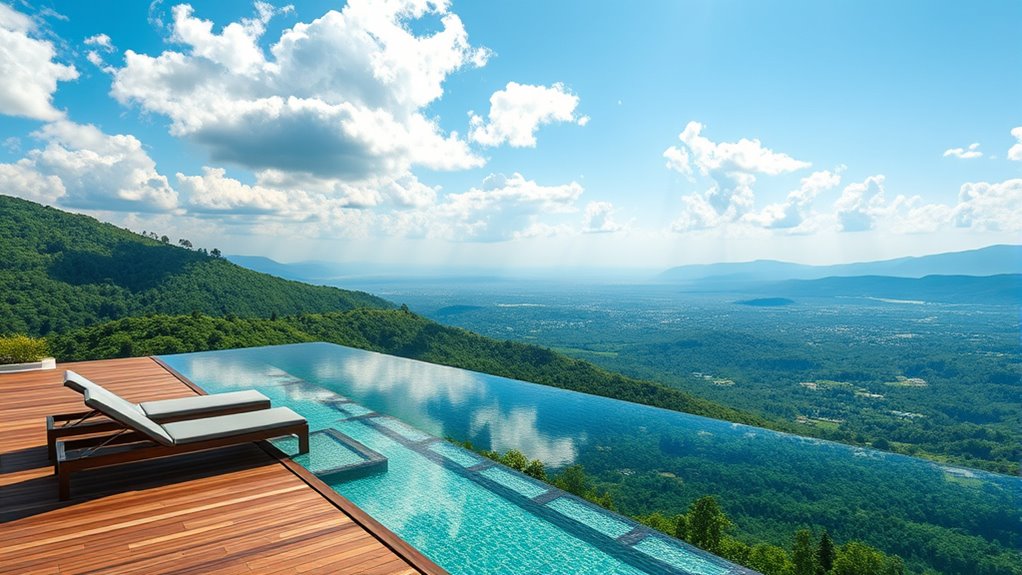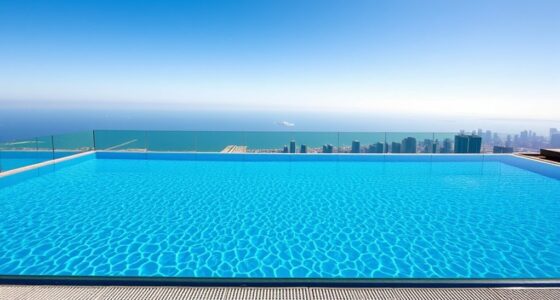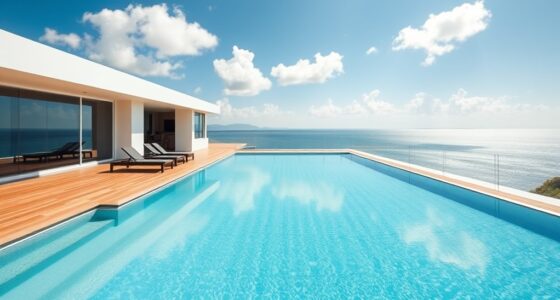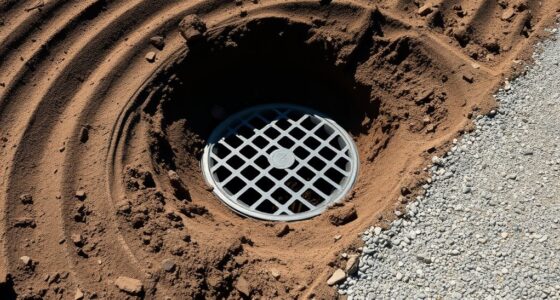To site an infinity pool on a hillside, you need to assess the slope, soil stability, and drainage to guarantee safety and durability. Choose a location that offers stunning views and supports proper water flow away from the structure. Use reinforced foundations and retaining walls to handle the terrain’s challenges. Considering local regulations and working with professionals will help you create a beautiful, stable design. Keep exploring to discover more tips for perfect hillside pool placement.
Key Takeaways
- Assess slope stability, soil composition, and drainage to determine the optimal pool placement and foundation requirements.
- Position the infinity edge to maximize scenic views, considering sightlines and natural landscape features.
- Use reinforced foundations, retaining walls, and proper waterproofing to ensure structural stability on hillside terrain.
- Design effective drainage and water management systems to prevent erosion and manage runoff efficiently.
- Collaborate with experienced professionals to align design, safety standards, and local regulations for hillside construction.
Assessing Site Topography and Soil Conditions
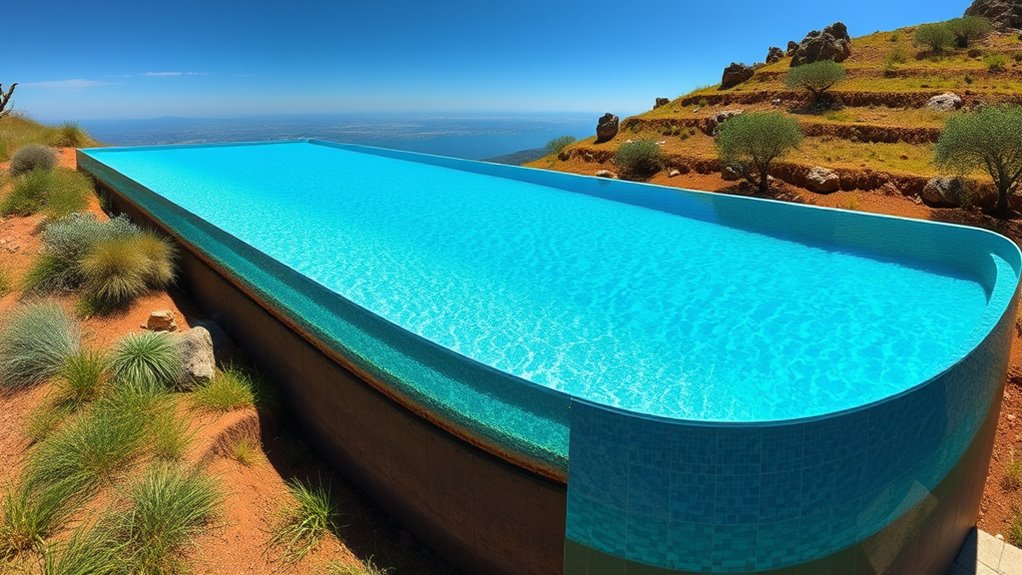
Before installing an infinity pool, you need to carefully evaluate the site’s topography and soil conditions. Start by examining the slope and elevation changes, as these influence the pool’s placement and drainage. A gentle slope offers better stability, while steep inclines may require more extensive grading. Next, assess the soil’s composition—clay, sand, or gravel—all affect how well the ground can support the structure. Conduct soil tests to determine load-bearing capacity and identify any drainage issues. Poor soil conditions, like expansive clay, can cause shifting or cracking, jeopardizing the pool’s integrity. Ensuring proper assessment helps you avoid future problems and provides a solid foundation for your infinity pool, especially on slopes or hillside sites. Additionally, understanding the soil’s drainage capacity can prevent water accumulation around the foundation, which is crucial for maintaining long-term stability.
Designing for Structural Stability and Safety

You need to guarantee your pool’s foundation and support systems are solid enough to handle the weight and movement. Proper load distribution is essential to prevent structural issues and keep safety your top priority. By carefully designing these elements, you’ll create a stable, secure infinity pool that stands the test of time. Incorporating load-bearing capacity considerations ensures the structure can withstand environmental and usage stresses over time.
Foundation and Support Systems
Ensuring the foundation and support systems are robust is essential for the structural stability and safety of an infinity pool. You need a solid base that can handle the weight and pressure, especially on a slope or hillside. Reinforced concrete footings and retaining walls are common solutions, providing stability and preventing shifting. It’s vital to consider soil type and drainage to avoid erosion or settling issues. Proper support design distributes the load evenly, reducing stress on the structure. The following table summarizes key foundation components:
| Component | Purpose | Material |
|---|---|---|
| Reinforced footing | Distributes weight evenly | Concrete + rebar |
| Retaining wall | Holds back soil and slope | Concrete/stone |
| Drainage system | Prevents water accumulation | Gravel, pipes |
| Soil stabilization | Prevents shifting or erosion | Geotextiles |
Additionally, assessing soil stability is crucial to ensure the foundation remains secure over time.
Load Distribution and Safety
Effective load distribution is critical for maintaining the structural stability and safety of an infinity pool, especially when it is built on uneven terrain. You need to make certain that the weight of the water, the pool structure, and surrounding soil are evenly transferred to the supporting foundation. Properly designed load paths prevent uneven settling, which could cause cracking or collapse. Use reinforced concrete, strategically placed beams, and load-bearing walls to distribute forces effectively. It’s essential to contemplate dynamic loads, such as people and environmental factors like wind and seismic activity. Regular inspections and maintenance help identify stress points early. By prioritizing balanced load transfer, you safeguard your pool against structural failure and ensure years of safe, enjoyable use. Incorporating vetted materials and proven construction techniques further enhances the durability and safety of hillside pools.
Navigating Permitting and Regulatory Requirements
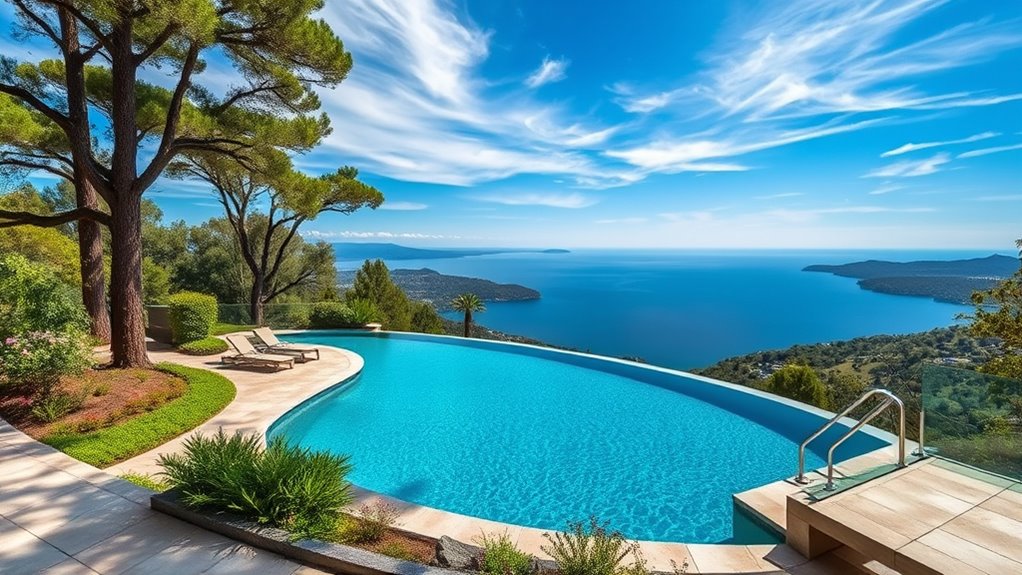
Managing permitting and regulatory requirements is a critical step in siting an infinity pool, as failure to adhere to can lead to costly delays or legal issues. To navigate this effectively, you should:
- Research local building codes and zoning laws that govern pool construction near slopes or hillside properties.
- Obtain necessary permits before starting construction, ensuring plans meet safety and environmental standards.
- Consult with local authorities or a professional planner to clarify restrictions, setbacks, and water management rules.
- Familiarize yourself with fraud detection techniques and ensure compliance with relevant safety regulations to prevent potential legal complications.
Ignoring these steps can result in project halts or fines. By proactively engaging with regulatory bodies and understanding requirements early, you reduce risks, streamline approval, and ensure your infinity pool project aligns with all legal and safety standards.
Selecting Materials and Construction Techniques
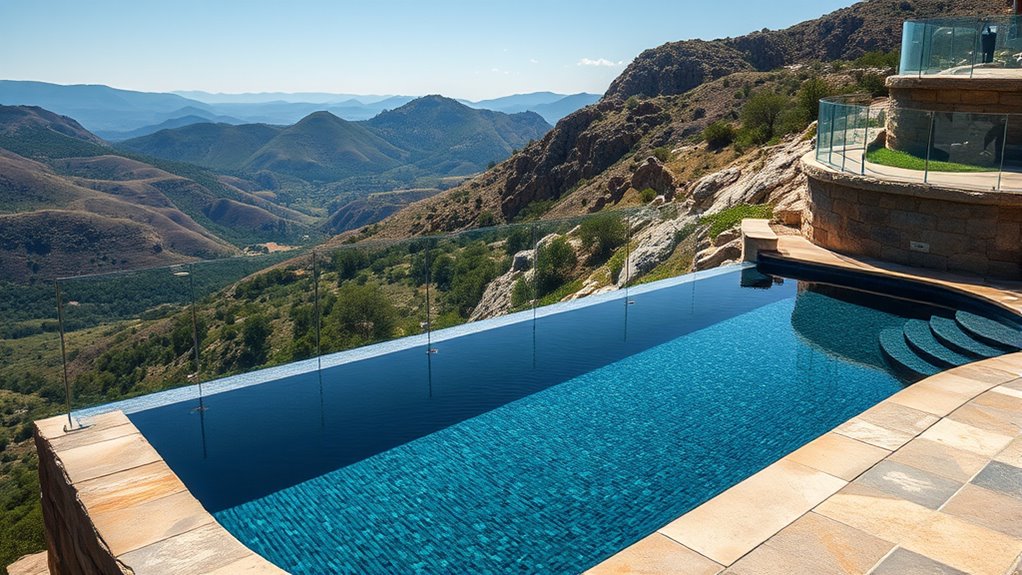
When choosing materials and construction methods for your infinity pool, you need to prioritize durability and strength. Opt for foundation materials that withstand shifting soil, and reinforce the structure to handle the pool’s weight and movement. Additionally, select weather-resistant surfaces that maintain their appearance and safety over time. Incorporating proper goal setting and planning can help ensure your project aligns with your long-term landscape and wellness objectives.
Durable Foundation Materials
Choosing the right foundation materials is essential to guarantee your infinity pool remains stable and long-lasting. The foundation supports the entire structure, especially on a slope or hillside. You should prioritize materials that resist shifting, cracking, and water damage. Consider these key options:
- Reinforced concrete with waterproofing to handle pressure and moisture.
- Compact gravel or crushed stone for proper drainage and stability.
- Steel reinforcement bars (rebar) to strengthen the concrete and prevent cracking.
Reinforced Structural Support
To guarantee your infinity pool can withstand the stresses it will face, selecting the right reinforced structural support is essential. You need strong materials like reinforced concrete or steel frameworks that can handle the weight of the water and the shifting soil on a slope. Use rebar or steel mesh to reinforce concrete, ensuring it resists cracking and settlement over time. Construction techniques should include deep pilings or retaining walls anchored securely to stable bedrock or solid fill. Properly designed supports distribute the load evenly, preventing sagging or collapse. Incorporate waterproofing and drainage considerations to protect your structure from erosion and water pressure. By choosing durable materials and sound techniques, you create a safe, stable foundation for your hillside infinity pool. High-quality materials are crucial for long-term durability and safety in hillside construction.
Weather-Resistant Surface Options
Selecting weather-resistant surface materials is essential for ensuring your infinity pool endures harsh environmental conditions. You need durable options that resist moisture, UV rays, and temperature fluctuations. First, consider natural stone like granite or slate, which offers high durability and aesthetic appeal. Second, porcelain tiles are resistant to staining, cracking, and fading, making them ideal for outdoor use. Third, composite decking materials such as capped polymer or PVC decking provide excellent weather resistance and low maintenance. When choosing materials, prioritize those with proven endurance against your local climate. Proper installation techniques, including waterproof membranes and sealed joints, further enhance longevity. Additionally, selecting bees and pollinators-friendly materials can support local biodiversity around your pool area. By selecting the right weather-resistant surfaces, you guarantee your infinity pool remains beautiful and functional for years to come.
Maximizing Views and Visual Integration

Maximizing views and achieving seamless visual integration are essential for creating a breathtaking infinity pool experience. To do this, position your pool where it captures the most stunning scenery. Use transparent barriers or glass edges to blur the line between water and landscape. Consider the pool’s orientation, aligning it with key vistas. Think about the surrounding landscape, removing obstructions or framing views with natural elements. Here’s a quick guide:
| Aspect | Tip | Benefit |
|---|---|---|
| Pool Position | Face main view | Maximize visual impact |
| Edge Design | Use glass or minimal barriers | Create seamless transition |
| Landscaping | Frame views with plants or structures | Enhance privacy and aesthetics |
| Pool Shape | Opt for natural or irregular shapes | Complement terrain |
| Lighting | Highlight key features at dusk | Extend viewing enjoyment |
Additionally, considering relationship principles such as open communication and mutual respect can help ensure the project aligns with everyone’s preferences and expectations.
Planning for Water Management and Drainage
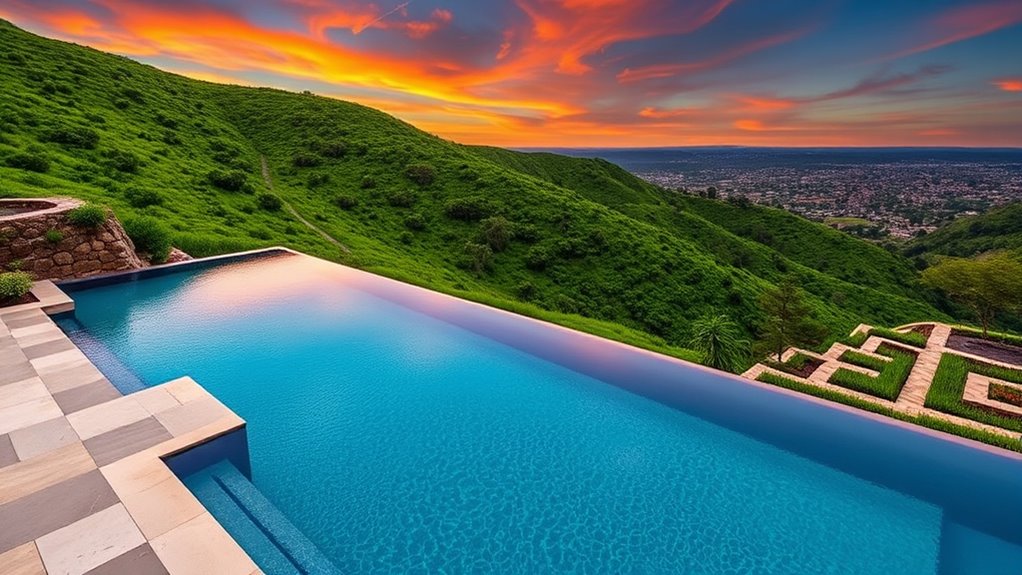
Have you considered how proper water management and drainage are essential to maintaining your infinity pool’s safety and longevity? If not, issues like erosion, pooling, or water damage could arise. To prevent this, focus on:
- Designing effective drainage systems that direct runoff away from the pool and hillside.
- Using permeable surfaces and landscaping to absorb excess water and reduce soil erosion.
- Implementing proper slope grading to ensure water flows naturally toward designated drainage points.
These steps help control water flow, prevent structural damage, and protect your landscape. Proper planning minimizes water buildup, reduces maintenance needs, and guarantees your infinity pool remains a beautiful, safe feature on your hillside. Prioritize water management now to enjoy long-term peace of mind.
Collaborating With Professionals and Experts
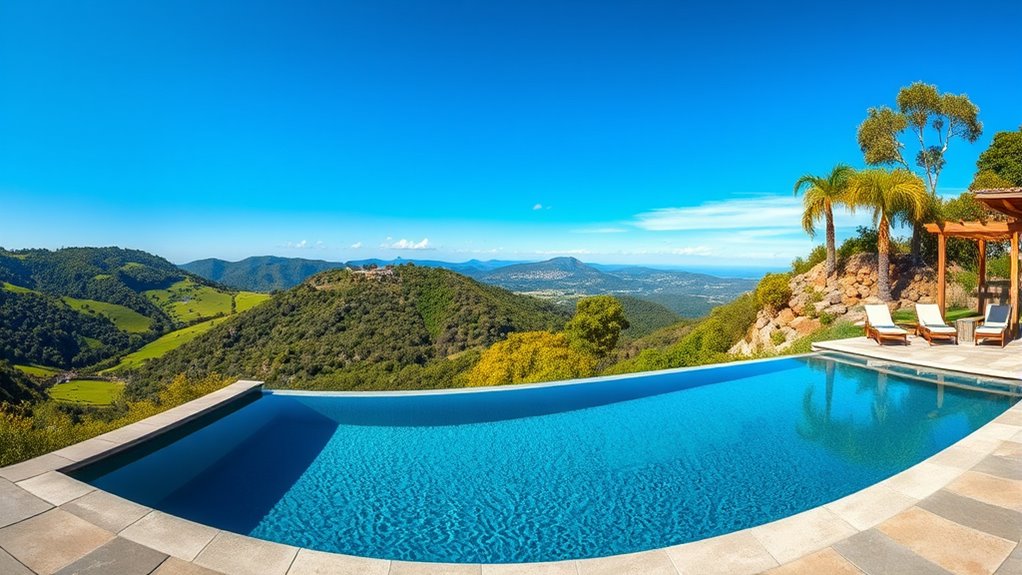
To guarantee your infinity pool is built correctly and safely, partnering with experienced professionals and experts is essential. Architects, landscape designers, and structural engineers bring valuable knowledge about hillside construction, ensuring your design integrates seamlessly with the terrain. They can assess soil stability, drainage issues, and load-bearing capacity, preventing future problems. Pool contractors with hillside experience can handle complex excavation and waterproofing requirements. Collaborating with these specialists saves you time, reduces costly errors, and ensures safety standards are met. Clear communication is key: share your vision, ask questions, and stay involved in decision-making. Their expertise helps you navigate permitting processes and select quality materials, making your hillside infinity pool a stunning, durable addition that complements your landscape. Additionally, understanding unique and wicked planters can inspire creative landscaping elements around your pool area, enhancing its overall aesthetic appeal.
Frequently Asked Questions
How Do I Maintain an Infinity Pool on a Constantly Shifting Hillside?
You can maintain your infinity pool on a shifting hillside by installing a reinforced, flexible foundation that adapts to ground movement. Regularly inspect and service the structural supports and waterproofing to prevent leaks caused by shifting soil. Using adjustable, high-quality mechanical systems helps manage water level changes. Consulting with a geotechnical engineer ensures your pool’s design accounts for hillside movement, keeping it safe and functional over time.
What Are the Long-Term Costs of Maintaining a Hillside Infinity Pool?
Long-term costs of maintaining a hillside infinity pool can be surprising. While the initial investment is high, ongoing expenses include regular structural inspections, erosion control, and sediment management. You’ll also need to budget for seasonal cleaning, water treatment, and potential repairs due to shifting terrain. These costs add up over time, but with proper upkeep, you’ll enjoy stunning views and a luxurious retreat that’s worth every penny.
Can an Infinity Pool Be Installed on a Very Steep Slope?
Yes, you can install an infinity pool on a very steep slope, but it requires careful planning and expert engineering. You’ll need a reinforced structure, proper drainage, and retaining walls to guarantee stability. Keep in mind that construction costs and long-term maintenance might be higher due to the challenging terrain. Working with experienced architects and contractors will help you create a safe, stunning infinity pool that complements your hillside location.
How Do I Prevent Erosion Around the Pool Area?
To prevent erosion around your infinity pool, you should install proper drainage systems like French drains or swales to direct water away. Plant deep-rooted vegetation to stabilize the soil, and use retaining walls or terracing to reduce slope steepness. Regularly maintain your landscaping to prevent erosion from heavy rain or runoff. These steps help protect your pool area and keep the hillside secure and stable over time.
What Safety Features Are Essential for Hillside Infinity Pools?
Of course, you want every safety feature under the sun, but don’t forget the basics. Install sturdy fencing with a self-locking gate, add slip-resistant surfaces around the pool, and include a reliable alarm system. You’ll also want a clear, accessible emergency plan and proper lighting for night swims. Remember, the real luxury is peace of mind—so don’t skimp on safety, even if it’s tempting to focus on the view.
Conclusion
When siting an infinity pool on a hillside, careful planning guarantees safety and beauty. Did you know that proper drainage and soil assessment can reduce structural risks by up to 70%? By working with experts and choosing the right materials, you’ll create a stunning, safe oasis that maximizes views and complements your landscape. Remember, thoughtful design and professional guidance are key to turning your hillside infinity pool dreams into reality.
